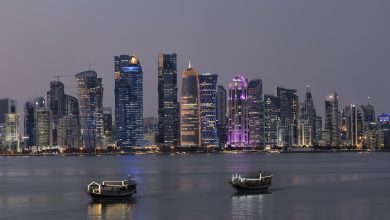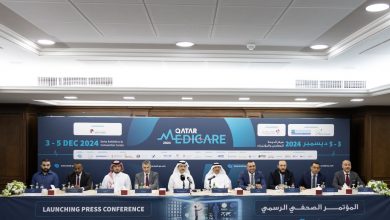
HMC Continues Providing Innovative Treatments for Cardiac, Cerebral Strokes
حمد الطبية تواصل تقديم عناية فائقة لعلاج الجلطات القلبية والدماغية
QNA
Doha: Despite the challenges imposed by Coronavirus (COVID-19), the Hamad Medical Corporation (HMC) persistently continues providing personalized and innovative treatments through Heart Hospital for the various types of patients, including patients whose health condition requires emergency therapeutic cauterization to treat strokes and strokes.
Treating cardiac and cerebral strokes by removing clots through therapeutic cauterization is one of the modern methods and techniques that HMC medical teams have been following for many years, as they are the most effective methods, which have proven extremely successful in saving many lives and minimizing the negative effects and the consequent damages resulting from these clots.
Senior Consultant Cardiologist at the Heart Hospital Dr. Omar Al Tamimi said that despite the COVID-19 pandemic and the precautionary measures taken by hospitals in various parts of the world, the Heart Hospital did not stop providing treatment services to various patients, including emergency therapeutic catheterization to treat heart attacks, as the medical teams at the Heart Hospital take all necessary precautions and protective measures to, successfully, combat COVID-19. Hence the number of daily heart cases treated in the Heart Hospital is not affected; whereas more than (1000) severe and acute heart strokes have been treated, in 2020, through therapeutic catheterization, to raise the number of the cases treated since the provisioning of the around O’clock therapeutic services, seven years ago, to (6) thousands cases with a total success of 95%.
He pointed out that during the COVID-19 pandemic, this emergency catheterization was performed on a number of patients who were found to have COVID-19, adding about 60 cases of those with COVID-19 have been successfully treated since the beginning of the pandemic until now.
Al Tamimi added that diagnosing the patient’s condition as an acute heart attack is by determining the type of pain, such as changes in the ECG, rise in heart enzymes and other criteria. Then, the patient is transported through the ambulance service to the Heart Hospital, specifically to the Cardiac Catheterization Laboratory for emergency catheterization to open the blocked artery. The more rapid the intervention is during the first 90 minutes of a stroke, the better is the result, and the less is the damage resulting from the blockage of the artery, he said.
Dr. Al Tamimi explained that the emergency cardiac clot is usually the result of a blood clot in one of the coronary arteries that causes it to be completely blocked. Here, the intervention is through the emergency catheterization treatment by inserting an ultrafine tube through an artery in the upper thigh or the wrist, he said, adding the tube is connected to the coronary arteries and then the arteries are injected by this tube with a colored material and x-rays are made from various angles to identify the damaged artery. Then, it can be determined if there is a problem such as narrowing or complete blockage, and the treatment is usually using a balloon and placing a stent and sometimes it is possible by opening the artery by sucking and pulling the clot with certain devices. This process often takes only about 40 minutes for most patients, but some cases may require a longer time due to the varying changes according to the type of patients, he said.
The use of emergency therapeutic catheterization is not only limited to treating heart clots, but HMC has also been proactive in using it in treating strokes.
In this context, senior consultant and director of the therapeutic catheterization unit for vascular nervous system at Hamad General Hospital Dr. Ayman Zakaria explained that despite the challenges faced and are still facing the medical sector in the State of Qatar as a result of the COVID-19 pandemic, the unit’s team continued to provide services to vascular patients of various age groups such as structural defects, atherosclerosis, birthmarks in the brain and spinal cord, hemorrhagic aneurysms and treatment of cerebral thrombosis.
He said that patients are treated by using the latest technologies and equipment at the regional level, which would reduce the negative effects resulting from surgeries in cases of cardiac and cerebral strokes, and these modern technologies depend on the method of curative catheterization .
He added that the vascular therapeutic catheterization of the nervous system at HGH is currently witnessing, since the launch of the unit in 2016, an annual increase in the number of cases. The number of the cases treated during the past six years approximately reached (3) thousands. About (500) cases of Corona COVID-19 have been received, treated and cured in 2020.
He added that the State of Qatar is the first to successfully use these technologies in the region and save many lives, and the unit is one of the best vascular centers. Due to its reputation, some patients from outside the State of Qatar come from the neighboring countries to avail curative services.
The medical team at the vascular therapeutic lateralization of the nervous system of HGH works around the O’clock to provide the necessary medical care for the vascular disease patients of the various categories of age, using the latest therapeutic treatment technologies in the region, thing that highly contributes in mitigating the negative impacts of the surgical interventions of the cardiac and cerebral strokes.
قنا
الدوحة: أكدت مؤسسة حمد الطبية أنه رغم التحديات التي تفرضها جائحة كورونا (كوفيد-19)، وما تتطلبه من إجراءات استثنائية وتدابير وقائية خاصة، إلا أن مستشفى القلب التابع للمؤسسة لم يتوقف عن تقديم خدماته العلاجية للمرضى الذين يحتاجون الرعاية الطبية، ومنهم المرضى الذين تتطلب حالتهم الصحية إجراء عمليات القسطرة العلاجية الطارئة لعلاج الجلطات القلبية والدماغية.
ويعد علاج الجلطات القلبية والدماغية عن طريق إزالة الجلطة من خلال القسطرة العلاجية من الطرق والتقنيات الحديثة التي تتبعها الفرق الطبية بمؤسسة حمد الطبية منذ سنوات عديدة حيث تعد أكثر الأساليب فعالية، والتي أثبتت نجاحا بالغا في إنقاذ حياة الكثير من مرضى الجلطات والتقليل من الأثار السلبية والأضرار المترتبة على هذه الجلطات.
وقال الدكتور عمر التميمي استشاري أول أمراض القلب بمستشفى القلب إنه رغم جائحة (كوفيد-19) والإجراءات الاحترازية التي اتخذتها المستشفيات بمختلف أنحاء العالم لم يتوقف مستشفى القلب عن تقديم خدماته العلاجية لمختلف المرضى، ومن بينها القسطرة العلاجية الطارئة لعلاج الجلطات القلبية، حيث يقوم الفريق الطبي باتخاذ كافة الاحتياطات اللازمة لسلامته وسلامة المرضى، ولم يتأثر عدد الحالات التي يتم علاجها، حيث تم علاج ما يزيد عن 1000 حالة جلطة قلبية حادة باستخدام القسطرة العلاجية خلال عام 2020، ليصل عدد الحالات التي تم علاجها حتى الآن منذ توفير الخدمة العلاجية على مدار 24 ساعة منذ ما يزيد عن 7 سنوات حوالي 6 آلاف حالة، بنسبة نجاح تتجاوز 95 بالمئة منذ تطبيقها.
وأشار إلى أنه خلال جائحة كورونا (كوفيد-19) تم إجراء هذه القسطرة الطارئة على عدد من المرضى الذين تبين إصابتهم بـ (كوفيد-19)، حيث تم علاج حوالي 60 حالة مصابة بـ (كوفيد-19) بنجاح منذ بداية الجائحة حتى الآن.
وأضاف الدكتور التميمي أن تشخيص حالة المريض كنوبة قلبية حادة عن طريق تحديد نوعية الألم، كالتغييرات في تخطيط القلب وارتفاع إنزيمات القلب وغير ذلك من المعايير، عندها يتم نقل المريض عن طريق خدمة الإسعاف إلى مستشفى القلب وتحديدا إلى مختبر قسطرة القلب لإجراء القسطرة الطارئة لفتح الشريان المغلق في أسرع وقت ممكن، فكلما كان التدخل سريعا خلال الـ 90 دقيقة الأولى من حدوث الجلطة كلما كانت النتيجة مثالية ويقل الضرر الناتج عن انسداد الشريان.
وأوضح الدكتور عمر التميمي استشاري أول أمراض القلب بمستشفى القلب أن الجلطة القلبية الطارئة عادة تكون نتيجة وجود خثرة دموية بأحد الشرايين التاجية تتسبب في انسداده بشكل كامل، وهنا يتم التدخل عن طريق القسطرة العلاجية الطارئة، من خلال إدخال أنبوب متناهي الصغر عن طريق شريان أعلى الفخذ أو الرسغ، ويتم توصيل الأنبوب للشرايين التاجية، ومن ثم يتم حقن الشرايين بواسطة هذا الأنبوب بمادة ملونة وإجراء أشعة من مختلف الزوايا لتحديد الشريان المتضرر، ثم يتم تحديد إذا كان هناك مشكلة كضيق أو انسداد كامل، وهنا يكون العلاج عادة باستخدام البالون ووضع الدعامة وأحيانا يتم التمكن من فتح الشريان عن طريق امتصاص وسحب الجلطة بأجهزة معينة، وغالبا ما تستغرق هذه العملية حوالي 40 دقيقة فقط لدى معظم المرضى، ولكن قد تتطلب بعض الحالات وقتا أطول بحكم التغيرات المتفاوتة حسب نوعية المرضى.
ولا يقتصر استخدام القسطرة العلاجية الطارئة على علاج الجلطات القلبية فحسب، بل كانت مؤسسة حمد الطبية سباقة أيضا في استخدامها في علاج الجلطات الدماغية.
وفي هذا الإطار، أوضح الدكتور أيمن زكريا استشاري أول ومدير وحدة القسطرة العلاجية للأوعية الدموية بالجهاز العصبي بمستشفى حمد العام أنه رغم التحديات التي واجهت ولا زالت تواجه القطاع الطبي في دولة قطر جراء جائحة /كوفيد-19/، إلا أن فريق عمل الوحدة يقدم خدماته لمرضى الأوعية الدموية من مختلف الفئات العمرية مثل العيوب التكوينية، وتصلب الشرايين، والوحمات الدموية بالمخ والنخاع الشوكي، والتمددات الشريانية النازفة وعلاج الجلطات الدماغية.
وقال إنه يتم علاج المرضى عن طريق أحدث التقنيات والمعدات على مستوى المنطقة، والتي من شأنها التقليل من الآثار السلبية الناتجة عن العمليات الجراحية لحالات الجلطات والسكتات الدماغية، وتعتمد هذه التقنيات الحديثة على أسلوب القسطرة العلاجية.
وأضاف أن الوحدة تشهد زيادة سنوية في أعداد الحالات التي يتم علاجها منذ افتتاحها عام 2016 ليصل إجمالي الحالات التي تم علاجها خلال الست سنوات الماضية حوالي 3 آلاف حالة، وتم استقبال وعلاج ما يقرب من 500 حالة خلال العام الماضي 2020 في ظل انتشار وباء /كوفيد-19/.
وأوضح الدكتور أيمن زكريا أن دولة قطر تعد من أوائل الدول بالمنطقة التي أدخلت هذه التقنية الحديثة، وتعد وحدة القسطرة العلاجية من أفضل مراكز علاج الجلطات ونظرا لصيتها الذائع يأتي إليها بعض المرضى من خارج دولة قطر من الدول المحيطة لتلقي الخدمة العلاجية.
ويتطلب علاج حالات الجلطة الدماغية عن طريق القسطرة العلاجية التدخل بعد حدوث الجلطة خلال فترة تتراوح من (6- 8) ساعات وفي حالات قليلة قد تمتد إلى 24 ساعة، ويتم تشخيص الحالة في قسم الطوارئ وإجراء الأشعة اللازمة وتحديد إجراء التدخل عن طريق القسطرة لإزالة الجلطة بعد التأكد من الجلطة نتيجة غلق شريان رئيسي وأن خلايا المخ لا زالت حية.
وتقدر نسبة نجاح هذا الأسلوب العلاجي المبتكر في علاج الجلطات الدماغية بحوالي 90 في المائة، بينما كان الأسلوب العلاجي الوحيد المتاح لإزالة الخثرات لدى مرضى السكتة الدماغية الحادة يتمثل في حقن المرضى بالأدوية المذيبة للخثرات، وهو أسلوب أقل فعالية من الأسلوب الحالي ولا تتعدى نسبة نجاحه 30 بالمئة.
وبالإضافة إلى تحسين النتائج العلاجية، ساعد هذا الأسلوب العلاجي المبتكر أيضا في تقليل عوامل الخطورة والمضاعفات الناتجة عن الأساليب التقليدية، وتقليل فترة النقاهة ومدة بقاء المريض في المستشفى، مما يخفض بشكل كبير من تكلفة علاج المريض الناتجة عن طول فترة بقائه وتأهيله بالمستشفى.



